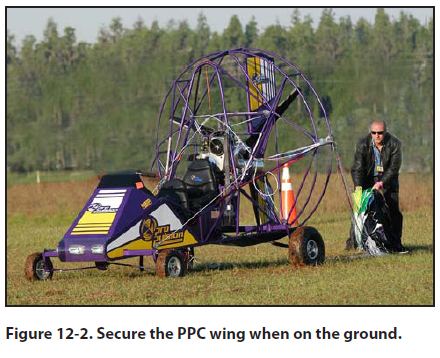|
Chapter 12 — Night, Abnormal, and Emergency Procedures
Accidents
It is estimated that 85 percent of accidents occur during
the takeoff process, 10 percent transpire during
landings, and 5 percent happen in flight. The vast
majority of these accidents are the direct result of
complacency. The cause of this complacency is that
the PPC is relatively easy to fly. Hence, if you find
complacency setting in, you need to turn from outside
distractions, and direct your attention to the immediate
situational awareness of the aircraft.
The following are some reasons for PPC complacency
during flight:
• The PPC does not require quick reactions.
• When compared to other light-sport aircraft
(LSA), the PPC flies very slowly.
• The PPC has only two axes around which you
can directly control (lateral-pitch and verticalyaw).
Note: As there are no ailerons on a PPC,
roll or movement around the longitudinal axis
cannot be directly controlled. However, there
is longitudinal roll invoked during a steep turn
as the centrifugal force of the cart directs the
cart to the outside of the suspension point of the
wing.
• The controls are very intuitive (push right to go
right, left to go left, more throttle to go up, and
less to go down).
It is possible the outside environment can become a
distraction to the necessary situational awareness of
flying (i.e., situational complacency). Hence, in-flight
accidents can be due to the pilot’s failure to see obstructions
(power lines and tower cables) and to anticipate
weather-related turbulence and its resultant
negative effects on a PPC’s light wing (i.e., wind
rotors or mechanical turbulence). Landing accidents
are usually the result of porpoising (too rapid throttle
movements), thermals, or unsafe field terrain. Takeoff
problems can be caused by: (1) failure to get a wing LOC before adding airborne power; and (2) failure to
take off into the wind.
Potential Hazards of the Standing PPC
Even while parked on the ground, high winds can pick
up the wing of an unsecured powered parachute and
begin carrying it away. To regain control of a freestanding
PPC with a semi-inflated, dragging wing,
rescuers need to grasp the steering lines—not the
cart! Then with a steering line in hand, pull the line
back toward the front of the cart (into the wind) and
tie it off to any structured part of the PPC. This will
keep the wing from gathering air and re-inflating. If
you are by yourself, you do not have to do both lines
simultaneously. It would be best to get both lines, but
with a PPC that is dragging down the field, grab any
steering line and get at least one line secured; then
secure the second line. When you pull a steering line,
the canopy will be pulled down on that side and the
air in the wing will literally be pulled out, as the wing
is hauled back and down.
The best safety procedure is prevention. To safeguard
a PPC from high winds, immediately after landing,
secure the wing. Even if you only intend to refuel, it is
highly recommended to condense the exposure of the
wing to the elements: the harmful ultraviolet rays of
the sun and those unexpected wind gusts. As soon as
possible after landing, condense the wing by folding it
on top of itself and put something on top of it to secure
it. It is best to pack the canopy to keep it out of the sun
and make sure the wind cannot inflate the wing and
if possible, lean the nose wheel up, then place the fan
guard of the cart back and down on the folded wing.
Securing it this way will usually be adequate for short
breaks when the make and model allows for this static
positioning. [Figure 12-2]

|

